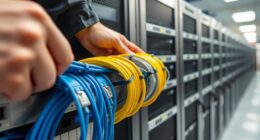Upgrading your network from 10G to 100G and beyond requires careful planning and strategic decision-making. You’ll need to evaluate your current infrastructure, select compatible high-quality transceivers, and consider phased approaches to minimize disruptions. Understanding how to leverage breakout cables or aggregation techniques can help you expand capacity incrementally. Staying ahead of evolving technology trends ensures your network remains scalable, reliable, and cost-effective as demands continue to grow.
Key Takeaways
- Assess existing infrastructure and fiber capacity to determine upgrade feasibility and plan for higher speeds.
- Select compatible optical transceivers like CFP or QSFP28 based on current hardware and future scalability needs.
- Implement phased migration using breakout cables or aggregation solutions to gradually increase network capacity.
- Prioritize high-quality, standards-compliant transceivers to ensure reliability and seamless integration.
- Plan infrastructure upgrades in alignment with business timelines to minimize downtime and support future growth.

As network demands continue to grow, migrating from 10G to 100G and beyond becomes essential for maintaining performance and scalability. This shift requires careful planning and the right technology choices, especially when it comes to optical transceivers. These devices are critical components in high-speed network upgrades, enabling faster data transmission over fiber optic links. When you’re planning a network upgrade, understanding the role of optical transceivers helps guarantee a smooth transition. They come in various types, such as SFP+, CFP, and QSFP28, each supporting different speeds and distances. Selecting the appropriate transceivers depends on your current infrastructure, future growth expectations, and the specific requirements of your network environment.
Network upgrade planning involves evaluating your existing infrastructure, identifying bottlenecks, and determining the most cost-effective path for scaling up. You should assess your fiber optic cabling to see if it supports higher speeds or if upgrades are needed. Moreover, consider compatibility issues—making sure the new 100G transceivers work seamlessly with your existing switches and routers. Compatibility not only prevents technical hiccups but also minimizes downtime during the migration process. It’s also wise to think about the deployment timeline, ensuring your upgrade aligns with business needs and avoids disrupting critical operations.
When moving from 10G to 100G, you might initially leverage breakout cables or aggregation solutions that allow multiple 10G links to connect into a single 100G port. This approach helps you scale your bandwidth gradually, especially if full 100G infrastructure isn’t immediately necessary everywhere. As you progress, replacing older 10G transceivers with higher-capacity optical transceivers becomes more feasible. The key is to plan a phased approach: start with critical links, test the new hardware thoroughly, and expand incrementally. This method reduces risk and allows troubleshooting on a smaller scale before full deployment.
Investing in high-quality optical transceivers is crucial because they directly impact network reliability and performance. Look for providers offering transceivers with proven standards compliance and long-term support. As you plan your upgrade, consider future growth—aim for scalable solutions that can handle even higher speeds beyond 100G. Proper network upgrade planning, combined with the right optical transceivers, guarantees your infrastructure stays competitive, resilient, and ready for the increasing data demands of tomorrow. Additionally, understanding fiber optic cabling and its capacity is essential for ensuring compatibility and effective performance at higher speeds.
Frequently Asked Questions
What Are the Main Cost Differences Between 10G and 100G Upgrades?
The main cost differences between 10G and 100G upgrades center on hardware investment and ongoing expenses. You’ll find that 100G hardware costs considerably more upfront, requiring advanced transceivers and switches. A thorough cost analysis reveals higher initial investments, but you may offset this with lower operational costs and increased capacity. While 10G is cheaper initially, 100G offers long-term scalability, making it a smart choice for future-proofing your network.
How Does Migration Impact Existing Network Security Protocols?
Imagine upgrading a fortress’s defenses; during migration, your security protocols face new vulnerabilities. You’ll need to reconfigure firewalls, update encryption, and monitor traffic more closely to maintain network integrity. This process can temporarily expose gaps, so proactive planning is essential. By carefully managing these changes, you guarantee your network remains resilient against threats, even as you shift to higher speeds and more robust infrastructure.
Are There Scalability Challenges When Moving Beyond 100G?
Yes, you’ll face scalability challenges beyond 100G, especially with network congestion and hardware limitations. As you push higher speeds, your existing infrastructure might struggle to handle increased data loads, leading to bottlenecks. Upgrading hardware components becomes essential, but it can be costly and complex. To overcome these issues, you need to plan carefully, optimize network design, and invest in scalable solutions that support future growth.
What Training Is Required for Network Staff During Migration?
You need to undergo targeted training covering protocol updates and advanced networking concepts to support migration. Make certain your staff obtains relevant certifications, such as Cisco CCNP or equivalent, to stay current with new standards. Hands-on workshops and simulation exercises will help you understand hardware upgrades and configuration changes. Staying updated on emerging protocols and best practices guarantees a smooth transition and maintains network performance during the migration process.
How Do Compatibility Issues Affect Multi-Vendor Network Environments?
Picture a symphony where each instrument must harmonize perfectly. Compatibility issues in multi-vendor networks can cause discord, as vendor interoperability and protocol compatibility gaps create miscommunication. These gaps lead to reduced performance, increased troubleshooting, and potential outages. To avoid dissonance, you need thorough testing, standardized protocols, and clear interoperability guidelines, ensuring all devices work seamlessly together, much like a conductor guiding a flawless orchestral performance.
Conclusion
Think of upgrading your network like renovating a house—you don’t tear down everything at once. Instead, you add new rooms gradually, ensuring everything fits perfectly. By carefully planning your migration from 10G to 100G and beyond, you’ll build a stronger, more scalable foundation. Just like upgrading your home increases its value, a well-executed network upgrade boosts your capacity and reliability, preparing you for future growth without chaos or costly surprises.









